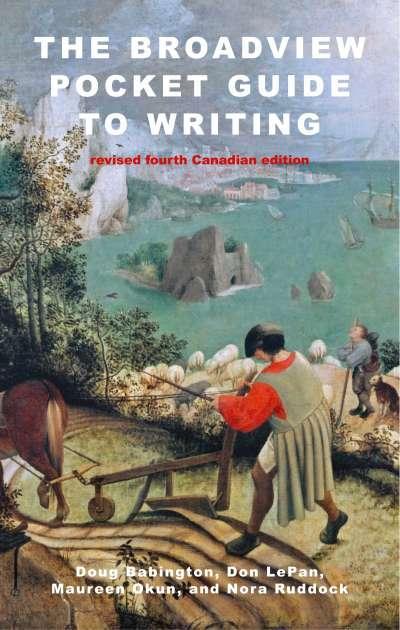
Broadview Pocket Guide To Writing Revised Cdn 4th Ed
The Broadview Pocket Guide to Writing is a concise volume presenting essential material from the full Broadview Guide to Writing. Included are summaries of key grammatical points; a glossary of usage; advice on various forms of academic writing; coverage of punctuation and writing mechanics; helpful advice on how to research academic papers; and much more. Four commonly-used styles of citation and documentation are covered—MLA, APA, Chicago, and CSE. The revised fourth edition includes full coverage of the 2016 MLA Style changes.
A new edition of the concise version of one of the most acclaimed writing handbooks—now with the MLA Style section fully revised to take account of the extensive 2016 changes.
The Broadview Pocket Guide to Writing is a concise volume presenting essential material from the full Broadview Guide to Writing. Included are summaries of key grammatical points; a glossary of usage; advice on various forms of academic writing; coverage of punctuation and writing mechanics; helpful advice on how to research academic papers; and much more. Four commonly-used styles of citation and documentation are covered—MLA, APA, Chicago, and CSE. The revised fourth edition includes full coverage of the 2016 MLA Style changes.
How to Use This Book and Its Companion Website
STYLES OF WRITING: AN OVERVIEW
Choosing the Best Words Be as Clear and Specific as Possible Watch for Redundancy Avoid Wordiness Watch for Missing Parts Choose the Best Verb Connect Your Ideas Clearly Paragraphing Joining Words Order and Weight Your Ideas According to Their Importance Watch for Ambiguity Illogical or Confused Connections Making Your Writing Consistent Agreement among the Grammatical Parts of Your Writing Watch for Mixed Metaphors Rhythm, Variety, Balance, and ParallelismCONTEXTS OF WRITING
Academic Writing: Essays and Arguments From Topic to Thesis Statement The Nature of Argument Argument Structure and Paragraphing Your Arguments, Others’ Arguments Styles and Disciplines The Language of Academic Writing Writing about Literature / Writing about Texts Writing about Science Business and Professional Writing Slang and Informal English The Social Context Gender Race and Ethnicity, Class, Religion, Sexual Orientation, Disability, etc. Bias-free Vocabulary: A Short ListGRAMMAR
Basic Grammar: An Outline Parts of SpeechNouns
Pronouns
Articles
Adjectives
Verbs
Adverbs
Prepositions
Conjunctions and Conjunctive Adverbs Parts of Sentences
Subject
Object
Predicate
Clauses and Phrases
Parts of Speech and Parts of the Sentence Verbs and Verb Tense Difficulties The Infinitive The Simple Present Tense Subject-Verb Agreement Historical Present Survey of Verb Tenses Voice Mood
Combining Verb Tenses: Some Challenges The Past Perfect Tense Combining Tenses—Quoted Material Irregular Verbs Dangling Constructions Nouns and Pronouns Singular and Plural Nouns Singular Pronouns Unreferenced or Wrongly Referenced Pronouns Subject and Object Pronouns Adjectives and Adverbs Comparatives and Superlatives Sentence Fragments / Incomplete Sentences Comma Splices / Run-on Sentences EAL: For Those Whose Native Language Is Not English Articles Frequently Used Non-count Nouns Continuous Verb Tenses Omission or Repetition of the Subjec The Conditional
PUNCTUATION
The Period The Comma Commas and Non-restrictive Elements That and Which Extra Comma Commas and Lists The Question Mark The Exclamation Mark The Semi-Colon The Colon The Hyphen The Dash Parentheses Square Brackets The Apostrophe Contractions Possession Quotation Marks Other Uses of Quotation Marks Misuse of Quotation Marks to Indicate Emphasis Single Quotation Marks Direct and Indirect Speech EllipsesFORMAT AND SPELLING
Capitalization Abbreviations Titles Academic and Business Terms Latin Abbreviations Numbers Italics Spelling Spell-Check Spelling and Sound American Spelling, British Spelling, Canadian Spelling Other Spelling MistakesRESEARCH AND DOCUMENTATION
Approaches to Research Avoiding Plagiarism Citation and Documentation Incorporating SourcesSummarizing
Paraphrasing
Quoting Directly
Formatting Quotations
Adding to or Deleting from a Quotation
Signal Phrases MLA Style About MLA In-Text Citations
About Works Cited: MLA Core Elements
Examples MLA Style Sample Essay Page APA Style Incorporating Sources in APA Style
Summarizing
Paraphrasing
Quoting Directly
Formatting Quotations
Adding to or Deleting from a Quotation
Signal Phrases About In-text Citations About References APA Style Sample Essay Pages Chicago Style About Chicago Style Chicago Style Sample CSE Style CSE Style Samples
GLOSSARY OF USAGE
CORRECTION KEY
INDEX
Comments on the full Broadview Guide to Writing:
“The Broadview Guide remains the most readable writing guide available—at any price. It’s the only usage guide I’ve ever actually read for fun. Moreover, it’s sensible, and it’s complete. The authors assume nothing, but they don’t condescend. … The 6th edition gives more space to the problems of gender, race, and class-biased language; most guides don’t direct enough of our attention here. The new chapter on visual literacy is also good—an interesting group of paintings & photographs along with a set of clear, concrete ways to ‘read’ them.” — Jacky Bolding, University of the Fraser Valley
“… an excellent choice.… The expanded coverage of the sixth edition [makes] this not only a comprehensive writing guide, but also a valuable introduction to communication and critical thinking in today’s academic world. I will be recommending this text to students at all levels.” — Maria DiCenzo, Wilfrid Laurier University
“[The] reference sections on grammar and usage … cover everything I would ever point out in student writing.… The section on MLA style covers pretty much everything anyone needs to know about how to deploy this system of documentation.… The sections on academic writing are [also] very good.” — Bruce Greenfield, Dalhousie University
“In a market replete with writing guides, this practical book stands out…. The [Broadview] Guide … re-energizes this pedagogical field by providing clear and concise explanations supported by examples.” — Anne Quéma, Acadia University
“[The new] section on how language both reflects and shapes reality … is thought-provoking and sensitive.… Overall, the book is comprehensive, balanced, and engaging. I enjoyed reading it, and I rarely say that about handbooks and guides to writing. I’m sure students will find this book helpful and inspiring.” — Candace Fertile, Camosun College



